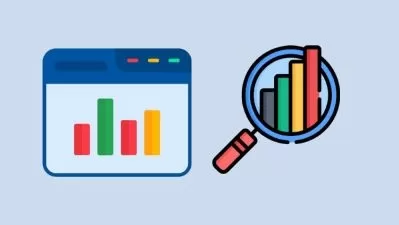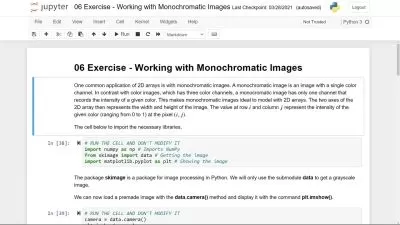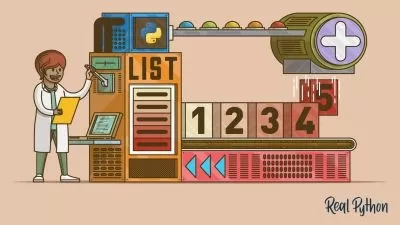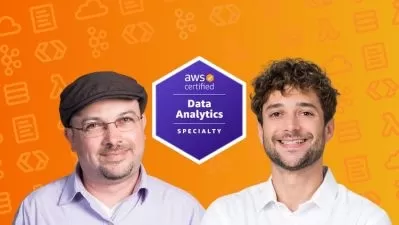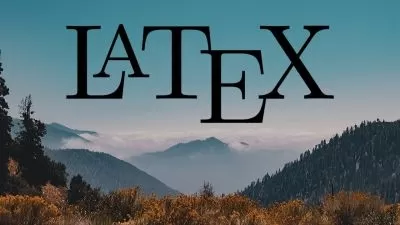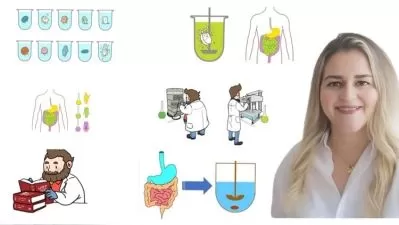Graph Generation for Drug Discovery using Python and Keras
Karthik K
1:24:54
Description
Python-based Graph Generation for Molecular Structures using Keras: A Practical Introduction to Neural Network Modeling
What You'll Learn?
- Understand the basics of graph generation and its applications in various fields.
- Learn how to manipulate molecular structures using the RDKit library in Python.
- Gain proficiency in preprocessing chemical data stored in CSV files.
- Develop an understanding of mapping atom symbols and bond types to numerical representations.
- Learn to convert SMILES strings into graph representations.
- Understand the concepts of Generative Adversarial Networks (GANs) and their application in graph generation.
- Implement a Graph Generator using TensorFlow and Keras to generate molecular graphs.
- Create a Discriminator model to evaluate the quality of generated graphs.
- Learn about the Wasserstein GAN framework for improved GAN training stability.
- Gain hands-on experience in training and fine-tuning GAN models for graph generation tasks.
- Understand the importance of GPU acceleration and how to configure it for faster computations.
- Develop the ability to save and load model weights for future use.
- Gain proficiency in generating molecular graphs using the trained GAN model.
- Learn to visualize and analyze the generated molecular structures.
Who is this for?
What You Need to Know?
More details
DescriptionAre you curious about the world of molecular structures, drug discovery, and generative models? Look no further! This exciting course will take you on a journey through the fascinating field of graph generation and its real-world applications.
In this course, we will start by exploring the basics of molecular representations using SMILES notation and how to convert them into graph structures using the powerful RDKit library. You will learn how to handle and manipulate molecular data efficiently.
Next, we will dive into the realm of generative models, specifically GraphWGAN (Graph Wasserstein Generative Adversarial Network). You will gain an understanding of how GraphWGAN combines the power of generative adversarial networks (GANs) and graph neural networks (GNNs) to create realistic and diverse molecular graphs.
Throughout the course, we will build and train both the generator and discriminator models, learning how they work together to create new molecules that closely resemble real chemical compounds. As we progress, you will discover the art of hyperparameter tuning and optimizing the training process to achieve better results.
But the journey doesn't end there! We will explore various real-world applications of graph generation, particularly in drug discovery and materials science. You will witness how this cutting-edge technology is revolutionizing the pharmaceutical industry, accelerating the process of drug development, and contributing to groundbreaking research.
As we delve into the practical aspects of this course, you will gain hands-on experience working with TensorFlow, Keras, and other essential libraries, honing your skills in machine learning and data manipulation.
By the end of this course, you will be equipped with the knowledge and skills to tackle graph generation tasks independently. You will also have a portfolio of impressive projects that showcase your expertise in this exciting field.
The job prospects in the world of graph generation and artificial intelligence are booming! Industries such as pharmaceuticals, biotechnology, and materials science are actively seeking professionals who can leverage the power of graph generation models for innovative research and product development. So, this course can open doors to exciting job opportunities and career growth.
So, if you are ready to embark on a journey that merges chemistry, artificial intelligence, and real-world impact, join us for this thrilling course on Graph Generation using GraphWGAN. Let's uncover the secrets of molecular structures and unleash the power of generative models together!
Enroll now and let the adventure begin!
Who this course is for:
- Beginners in Machine Learning: If you're new to the field of machine learning and want to learn how to generate molecular graphs using advanced techniques, this course will provide a gentle and comprehensive introduction.
- Aspiring Data Scientists: If you're aspiring to become a data scientist or work in the domain of chemistry-related data analysis, this course will equip you with valuable skills in graph generation and neural networks.
- Chemistry Enthusiasts: If you have a background or interest in chemistry and want to explore how machine learning can be applied to molecular structures and graph generation, this course will bridge the gap between chemistry and AI.
- Python Programmers: If you are already familiar with Python programming and want to expand your knowledge into the realm of graph-based machine learning, this course will offer a structured pathway.
- Students and Researchers: Whether you're a student working on a project or a researcher looking to integrate graph generation into your work, this course will provide practical skills and knowledge to enhance your capabilities.
- Lifelong Learners: If you're simply curious about the intersection of machine learning, chemistry, and graph generation, this course welcomes learners of all backgrounds and experiences.
Are you curious about the world of molecular structures, drug discovery, and generative models? Look no further! This exciting course will take you on a journey through the fascinating field of graph generation and its real-world applications.
In this course, we will start by exploring the basics of molecular representations using SMILES notation and how to convert them into graph structures using the powerful RDKit library. You will learn how to handle and manipulate molecular data efficiently.
Next, we will dive into the realm of generative models, specifically GraphWGAN (Graph Wasserstein Generative Adversarial Network). You will gain an understanding of how GraphWGAN combines the power of generative adversarial networks (GANs) and graph neural networks (GNNs) to create realistic and diverse molecular graphs.
Throughout the course, we will build and train both the generator and discriminator models, learning how they work together to create new molecules that closely resemble real chemical compounds. As we progress, you will discover the art of hyperparameter tuning and optimizing the training process to achieve better results.
But the journey doesn't end there! We will explore various real-world applications of graph generation, particularly in drug discovery and materials science. You will witness how this cutting-edge technology is revolutionizing the pharmaceutical industry, accelerating the process of drug development, and contributing to groundbreaking research.
As we delve into the practical aspects of this course, you will gain hands-on experience working with TensorFlow, Keras, and other essential libraries, honing your skills in machine learning and data manipulation.
By the end of this course, you will be equipped with the knowledge and skills to tackle graph generation tasks independently. You will also have a portfolio of impressive projects that showcase your expertise in this exciting field.
The job prospects in the world of graph generation and artificial intelligence are booming! Industries such as pharmaceuticals, biotechnology, and materials science are actively seeking professionals who can leverage the power of graph generation models for innovative research and product development. So, this course can open doors to exciting job opportunities and career growth.
So, if you are ready to embark on a journey that merges chemistry, artificial intelligence, and real-world impact, join us for this thrilling course on Graph Generation using GraphWGAN. Let's uncover the secrets of molecular structures and unleash the power of generative models together!
Enroll now and let the adventure begin!
Who this course is for:
- Beginners in Machine Learning: If you're new to the field of machine learning and want to learn how to generate molecular graphs using advanced techniques, this course will provide a gentle and comprehensive introduction.
- Aspiring Data Scientists: If you're aspiring to become a data scientist or work in the domain of chemistry-related data analysis, this course will equip you with valuable skills in graph generation and neural networks.
- Chemistry Enthusiasts: If you have a background or interest in chemistry and want to explore how machine learning can be applied to molecular structures and graph generation, this course will bridge the gap between chemistry and AI.
- Python Programmers: If you are already familiar with Python programming and want to expand your knowledge into the realm of graph-based machine learning, this course will offer a structured pathway.
- Students and Researchers: Whether you're a student working on a project or a researcher looking to integrate graph generation into your work, this course will provide practical skills and knowledge to enhance your capabilities.
- Lifelong Learners: If you're simply curious about the intersection of machine learning, chemistry, and graph generation, this course welcomes learners of all backgrounds and experiences.
User Reviews
Rating
Karthik K
Instructor's Courses
Udemy
View courses Udemy- language english
- Training sessions 37
- duration 1:24:54
- Release Date 2023/12/16






